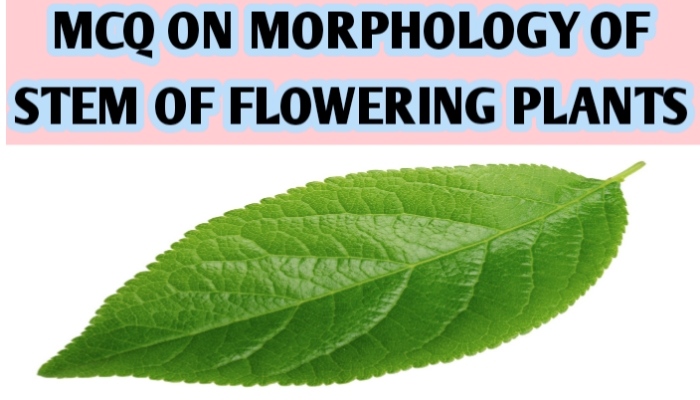MCQ ON MORPHOLOGY OF LEAF OF FLOWERING PLANTS class 11 for NEET | Morphology of LEAF of flowering plant class 11 MCQ | MORPHOLOGY OF LEAF OF FLOWERING with Answer | Check the below NCERT MCQ question for class 11 Biology chapter 5 based on MORPHOLOGY OF LEAF OF FLOWERING PLANTS with Answers.

MCQ ON MORPHOLOGY OF LEAF OF FLOWERING PLANTS
MCQ on Morphology of LEAF of Flowering Plants class 11 Biology with answers were prepared based on the latest pattern. We have provided class 11 Biology MCQs questions on MORPHOLOGY OF LEAF OF FLOWERING PLANTS with Answers to help students understand the concept very well.
MCQ on MORPHOLOGY OF LEAF OF FLOWERING PLANTS is useful for NEET / CSIR / UGC / CBSE / ICSE / AIIMS / EXAM / AFMC EXAM / JAC exam STATE LEVEL MEDICAL EXAM 2022-23
Introduction:-
The leaf is a green flat thin expanded lateral appendage of stem which is borne at a node and bears a bud in its axil . It is exogenous in origin and develops from the leaf primordium of shoot apex.The green colour of leaf is due to presence of the photosynthesis pigment chlorophyll which helps plants to synthesize organic food.
The green photosynthesis leaves of a plant are collectively called foliage.They are borne on stem in acropetal succession.
MCQ ON MORPHOLOGY OF LEAVES OF FLOWERING PLANTS class 11 for NEET
1. The leaf is a lateral , generally flattened structure borne on the .
(a) root
(b) stem
(c) leave
(d) all the above
Ans (b) stem
2. It develops at the nodes and bears a bud in its axil.
(a) stem
(b) root
(c) leaf
(d) all the above
Ans. (c) leaf
3. Leaves originate from shoot apical meristems and are arranged in an
(a) basipetal order
(b) acropetal order
(c) both a and b
(d) axillary buds
Ans. (b) acropetal order
ALSO READ:-
● YOU CAN WATCH BIOLOGY SIR Youtube channel
4. They are the most important vegetative organs for photosynthesis
(a) root
(b) stem
(c) leave
(d) all the above
Ans.(c) leaf
5. A typical leaf consists of three main parts
(a) leaf base
(b) petiole
(c) lamina
(d) all the above
Ans.(d) all the above
6.The leaf is attached to the stem by the
(a) leaf base
(b) vernation
(c) nodes
(d) all the above
Ans.(a) leaf base
7. In some leguminous plants the leaf base may become , which is called the
(a) pulvinus
(b) lamina
(c) leaf blade
(d) all the above
Ans.(a) pulvinus
8. It helps hold the blade to light
(a) petiole
(b) pulvinus
(c) lamina
(d) all the above
Ans.(a) petiole
9. It is the green expanded part of the leaf with veins and veinlets.
(a) the lamina
(b) leaf blade
(c) pulvinus
(d) both a and b
Ans. (d) both a and b
10. It provides rigidity to the leaf blade and acts as a channels of transport for water , minerals and food materials.
(a) veins
(b) veinlets
(c) leaf blade
(d) pulvinus
Ans. (a) veins
11. Insect catching leaves
(a) pitchers
(b) bladder
(c) drosera
(d) all the above
Ans.(d) all the above
12. The leaves of utricularia plant are modified into
(a) hooks
(b) tendrils
(c) bladders
(d) all the above
Ans.(c) bladders
13. The leaves of nepenthes and sarracena are modified into
(a) pistia
(b) bladders
(c) pitchers
(d) bith a and b
Ans.(c) pitchers
14. Phyllodes are flat green coloured leaf like modification of
(a) rachis
(b) petiole
(c) both a and b
(d) all the above
Ans.(c) both a and b
15. Reproductive part of bryophyllum
(a) root
(b) leaf
(c) stem
(d) bud
Ans. (b) leaf
16. The leaves are modified into insect catching pitchers ?
(a) nepenthes
(b) sarracenia
(c) both a and b
(d) terminal buds
Ans.(c) both a and b
17. The stomata are meant for gaseous exchange required for
(a) photosynthesis
(b) respiration
(c) both a and b
(d) transportation
Ans.(c) both a and b
18. In drosera mature leaves are spoon shaped and possess a large number of glandular hair called
(a) tentacles
(b) bladder
(c) nepenthes
(d) citrus and euphorbia
And.(a) tentacles
19. Heterophylly is common in ?
(a) amphibians plants
(b) phylloclades
(c) scales
(d) cladodes
Ans. (a) amphibians plants
20. Insect catching leaves
(a) nepenthes
(b) drosera
(c) utricularia
(d) all the above
Ans.(d) all the above







Leave a Comment